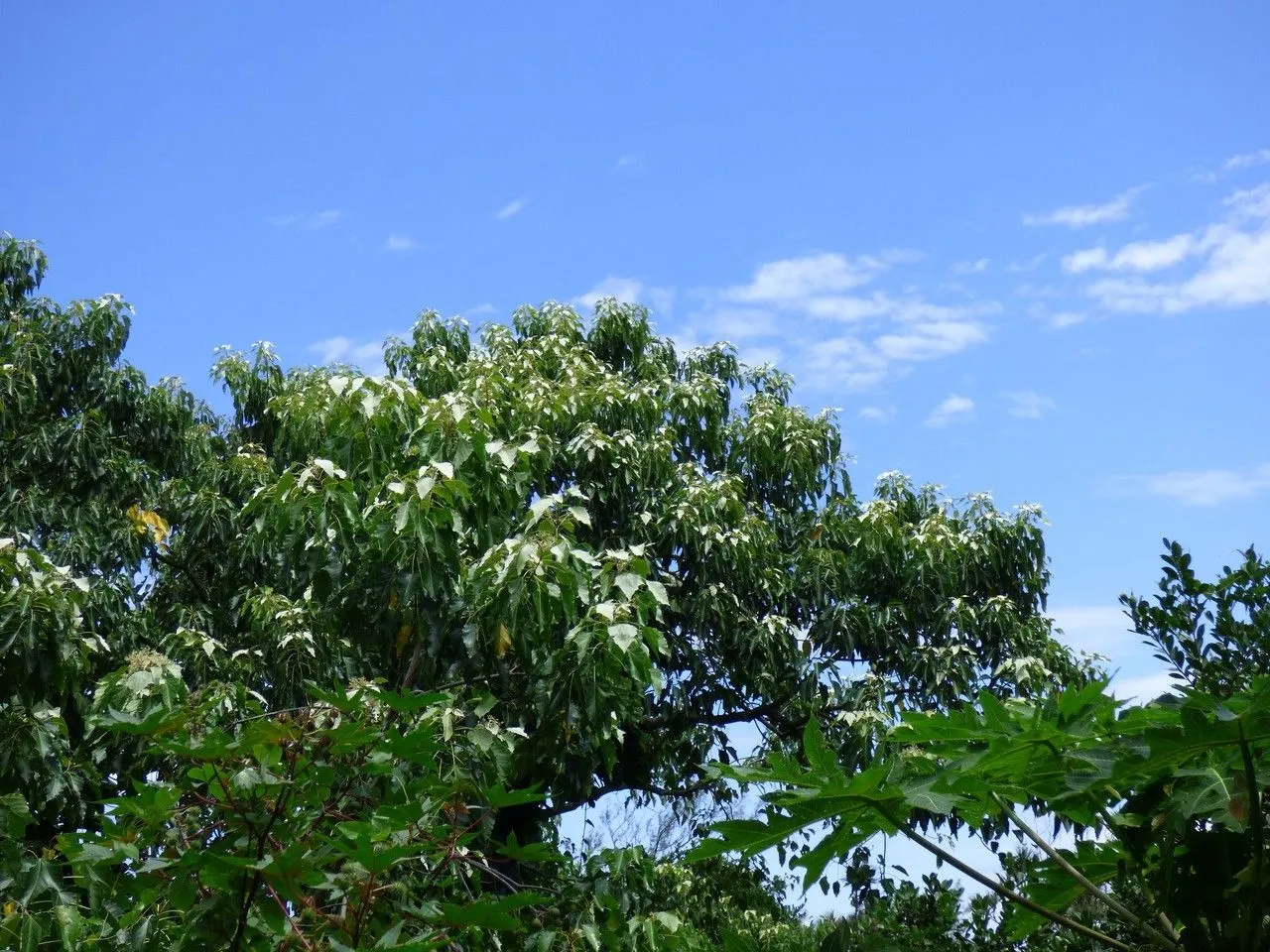
Author: (L.) Willd.
Bibliography: Sp. Pl., ed. 4, 4: 590 (1805)
Year: 1805
Status: accepted
Rank: species
Genus: Aleurites
Vegetable: False
Observations: Trop. & Subtrop. Asia to NW. Pacific
The Indian-walnut, scientifically known as Aleurites moluccanus, is a remarkable tree native to tropical and subtropical regions of Asia and the northwest Pacific. Described in the fourth edition of “Species Plantarum” (1805) by renowned botanist Carl Ludwig Willdenow, this species is recognized for its diverse applications and unique characteristics.
A member of the Euphorbiaceae family, Aleurites moluccanus is an essential part of the ecosystems within its native range. The tree thrives in a variety of climatic conditions, reflecting its adaptability to different environments. This characteristic enables it to play a vital role in the natural habitats where it grows.
The Indian-walnut stands out with its large, glossy leaves, which provide ample shade and contribute to the local flora’s biodiversity. Its most notable feature, however, is its seeds, known as candlenuts. These seeds are encased in hard shells and have a high oil content, which has been traditionally utilized in various ways.
Historically, the indigenous peoples of the tropics and subtropics have used the oil extracted from candlenuts for cooking, as a moisturizer, and even as a natural lamp oil. The high flammability of the oil lends itself to the traditional use of candlenuts as candles, hence the name “candlenut tree.” Additionally, the wood of Aleurites moluccanus is valued for its lightweight and durability, often used in crafting and construction.
Beyond its practical uses, Aleurites moluccanus holds cultural significance in many communities. It is often incorporated into traditional medicine and local rituals, demonstrating its integral role in the cultural fabric of the regions where it is found.
In summary, Aleurites moluccanus, or the Indian-walnut, is a multifaceted species with ecological, cultural, and practical importance. Its widespread presence across tropical and subtropical Asia to the northwest Pacific underscores its adaptability and significance, making it an invaluable component of the regions’ natural and human landscapes.
Eng: candlenut tree, indian walnut, indian-walnut, candle-nut, candleberry, candlenut, candlenut-tree, kukui, lumbangtree, varnishtree
Deu: lichtnußbaum
Spa: calumbán, camirio, lumbán
Swa: mkaa
Por: nogueira, nogueira-de-iguape, noz, noz-da-índia, noz-das-molucas
Fra: noyer de bancoul, noyer des moluques
En: Indian-walnut, Candleberry, Candlenut, Candlenut-tree, Varnishtree, Lumbangtree, Candle nut Tree, Indian walnut, Komèrè, Tingkih, ᨄᨛᨒᨛ, Candlenut tree, Candle-nut, Kukui, Buah Keras, Kukui Nut, Lambang, Tung-nut
Ar: ألوريتس
Zh: 石栗
Cs: Tungovník molucký
Nl: Kemirie
Et: Moluki tungpuu
Fi: Hopeatungpuu
Fr: Noyer de bancoul, Noyer des Moluques, Noisette des Grands Fonds
De: Lichtnußbaum, Lichtnussbaum
He: אגוז הודי
Id: Kemiri
Jv: Kemiri
Ms: Buah Keras
Fa: آلئوریتیس ملوکانوس
Pl: Tung molukański
Pt: Noz-da-Índia, Nogueira de Iguape, Nogueira, Nogueira-de-iguape, Noz, Noz-das-molucas
Pt-br: Nogueira-brasileira, Nogueira-da-Índia, Nogueira-de-iguape
Ru: Тунг молуккский
Es: Calumbán, Camirio, Lumbán
Su: Muncang
Sw: Mkaa
Ty: Tiairi
Zh-tw: 石栗
To: Tuitui
Zh-hant: 石栗
Uk: Свічкове дерево
© copyright of the Board of Trustees of the Royal Botanic Gardens, Kew.
© copyright of the Board of Trustees of the Royal Botanic Gardens, Kew.
© copyright of the Board of Trustees of the Royal Botanic Gardens, Kew.
Taken Jun 16, 2021 by Kai K (cc-by-sa)
Taken Feb 21, 2022 by Eligio Nicolas Bogado Mercado (cc-by-sa)
Taken Dec 1, 2016 by Hugo SANTACREU (cc-by-sa)
Taken Jul 22, 2004 by Daniel Barthelemy (cc-by-sa)
Taken Nov 23, 2021 by Makoto Makoto (cc-by-sa)
Taken Nov 2, 2017 by Tela Botanica − Hugo SANTACREU (cc-by-sa)
Taken Feb 21, 2021 by jipi06 (cc-by-sa)
Taken Mar 27, 2022 by marie the mariani (cc-by-sa)
Taken Nov 2, 2017 by Tela Botanica − Hugo SANTACREU (cc-by-sa)
Taken Dec 26, 2011 by Tela Botanica − Yoan MARTIN (cc-by-sa)
Taken Dec 1, 2016 by Hugo SANTACREU (cc-by-sa)
Taken Dec 1, 2016 by Hugo SANTACREU (cc-by-sa)
Taken Jul 12, 2018 by Mirhani Nourddine (cc-by-sa)
Taken Nov 6, 2018 by Dieter Albrecht (cc-by-sa)
Taken Dec 1, 2016 by Hugo SANTACREU (cc-by-sa)
Taken Nov 2, 2017 by Tela Botanica − Hugo SANTACREU (cc-by-sa)
Taken Nov 2, 2017 by Tela Botanica − Hugo SANTACREU (cc-by-sa)
Taken Nov 2, 2017 by Tela Botanica − Hugo SANTACREU (cc-by-sa)
Taken Dec 1, 2016 by Hugo SANTACREU (cc-by-sa)
Taken Nov 23, 2021 by Makoto Makoto (cc-by-sa)
Taken Jul 12, 2018 by Mirhani Nourddine (cc-by-sa)
Taken Feb 2, 2022 by Thiago Flores Flores (cc-by-sa)
Taken Dec 26, 2011 by Tela Botanica − Yoan MARTIN (cc-by-sa)
Taken Mar 7, 2012 by Tela Botanica − Yoan MARTIN (cc-by-sa)
Taken Mar 7, 2012 by Tela Botanica − Yoan MARTIN (cc-by-sa)
Taken Aug 21, 2022 by Anatas (cc-by-sa)
Taken Mar 7, 2012 by Tela Botanica − Yoan MARTIN (cc-by-sa)
Growth form>: Single Stem
Growth habit>: Tree
Growth rate>: Moderate
Ph maximum: 7.0
Ph minimum: 5.5
Family: Myrtaceae Author: (F.Muell.) K.D.Hill & L.A.S.Johnson Bibliography: Telopea 6: 402 (1995) Year: 1995 Status:…
Family: Rubiaceae Author: Pierre ex A.Froehner Bibliography: Notizbl. Bot. Gart. Berlin-Dahlem 1: 237 (1897) Year:…
Family: Sapindaceae Author: Koidz. Bibliography: J. Coll. Sci. Imp. Univ. Tokyo 32(1): 38 (1911) Year:…
Family: Asteraceae Author: A.Gray Bibliography: Pacif. Railr. Rep.: 107 (1857) Year: 1857 Status: accepted Rank:…
Family: Fabaceae Author: Medik. Bibliography: Vorles. Churpfälz. Phys.-Ökon. Ges. 2: 398 (1787) Year: 1787 Status:…
Family: Aspleniaceae Author: (Cav.) Alston Bibliography: Bull. Misc. Inform. Kew 1932: 309 (1932) Year: 1932…